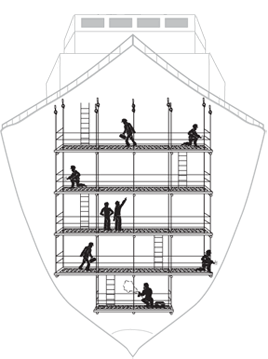Shipyard Employment eTool
Hanging Staging (Marine) >> Topic Glossary

Glossary of Marine Hanging Staging Terms
Angulated cable/roping: In marine hanging staging, a method of rigging suspension cables (wire ropes) to prevent uplift or displacement of their attachments to overhead anchorage points. With this rigging method, suspension cables are hung slightly off vertical and farther apart at their anchorage points than at their connections to the lowest platform level(s).
Backing rod: A short length of wire rope that serves as a spacer between the suspension cable and the "dead" sides of U-bolt-type wire rope clips. Backing rods should be 5/8-inch improved plow steel, independent wire rope core (IWRC) 6 by 7 wire rope.
Bedspring: A shipyard term for a manufactured metal scaffold plank. Synonyms: dimes, planks, staging boards.
Cable: See definition for "wire rope."
Cable installer or hanger: See definition for "rope walker."
Fall protection system: A system to keep workers from falling to lower levels. Three kinds of protection are suitable for marine hanging staging: (1) a guardrail system consisting of a rigid top rail at 42 to 45 inches above the platform, a middle rail located halfway between the upper rail and the platform, a toeboard, and related attachments; (2) a guardrail system consisting of two horizontal wire rope rails at intervals of 48 and 24 inches, and a safety screen between the top rail and the platform and related attachments; or (3) a personal fall arrest system meeting the requirements of 29 CFR 1915.159.
Marine hanging staging: A type of hanging scaffolding used for ship repair, incorporating tiers/levels of manufactured scaffold planks (attached to two pairs of wire ropes) suspended near-vertically from overhead anchorages.
Platform (alternative title: "Section"): A section (or "module") of marine hanging staging. A platform consists of four anchor attachments (S-hooks, pork chops, or beam clamps); four suspension cable assemblies; eight 5/8-inch wire rope clips; four backing rods; two struts; bedsprings wire-tied to the struts; and a fall protection system.
Pork chop: A shipyard term for a type of bracket used to attach a suspension cable assembly to an overhead L-shaped structural steel anchorage. This type of attachment engages portions of the top and bottom of the L's lower flange. Porkchops vary in size, based on flange width. As such, they must be designed and fabricated in accordance with accepted engineering principles.
Qualified Person: A person who by possession of a recognized degree or certification of professional standing, or who by extensive knowledge, training, and experience has successfully demonstrated the ability to solve or resolve problems related to the subject matter, the work, or the project. The Qualified Person is designated by an employer as responsible for erection, alteration, modification, disassembly, and any ongoing inspection of the staging.
Rat hole: See definition for "weep hole."
Rope walker: A person who installs anchorage attachments and suspension cable assemblies on the overheads of holds and at other heights where the use of conventional access equipment such as ladders, scaffolding, or lifts is either infeasible or potentially creates a greater hazard. Synonym: suspension cable installer or hanger. (This section of the eTool includes video clips of rope walking.)"
S-hook: A type of attachment between a support cable assembly and an overhead anchorage. Typically formed of steel bar stock, one leg of an S-hook is placed through a rat hole on an overhead structural steel support of a vessel or tank; the opposite leg is closed, forming an eye for attachment of a suspension cable assembly with a shackle.
Safety Hook: A means of attaching stirrups and personal fall protection equipment to overhead structural steel supports by cable installers/"rope walkers." See Illustration 1; see Illustration 2.
Safety screen: Flame-resistant plastic screening that supplements the fall protection characteristics of a guardrail.
Struts: The bearers that serve as supports for a stage's planks ("bedsprings"). Struts are typically 1½-inch diameter ASTM Schedule 40 pipe of varying lengths, with machined (not burned) notches at each end to receive the suspension cable assemblies. The struts bear on wire rope clips and backing rods attached at intervals along the lengths of the suspension cables.
Strut pin: A ¼-inch bolt or equivalent, at least 3 inches in length, with a locking nut that positively secures a strut to a suspension cable.
Suspension cable: A 5/8-inch improved plow steel, IWRC 6 by 7 (or greater, based on the intended load) wire rope having a nominal strength of not less than 17.1 tons that, when installed with others, forms the vertical supports for the scaffold's bearers ("struts").
Suspension cable assembly: A suspension cable with a closure formed by three wire rope clips at its top; a thimble to attenuate wear on the closure; a screw pin shackle having a working load of not less than 4,000 pounds for attachment to an S-hook, pork chop, or beam clamp; and wire rope clips and backing rods positioned at intervals along the length of the cable. See Illustration 3; see Illustration 4.
Weep hole: A shipyard term for the existing holes found on overhead structural steel supports in cargo holds, tanks, and other areas aboard a vessel. Synonym: rat hole.
Wire rope: A type of rope that consists of several strands of metal wire laid (or twisted) into a helix. [29 CFR 1915.112(b)].

